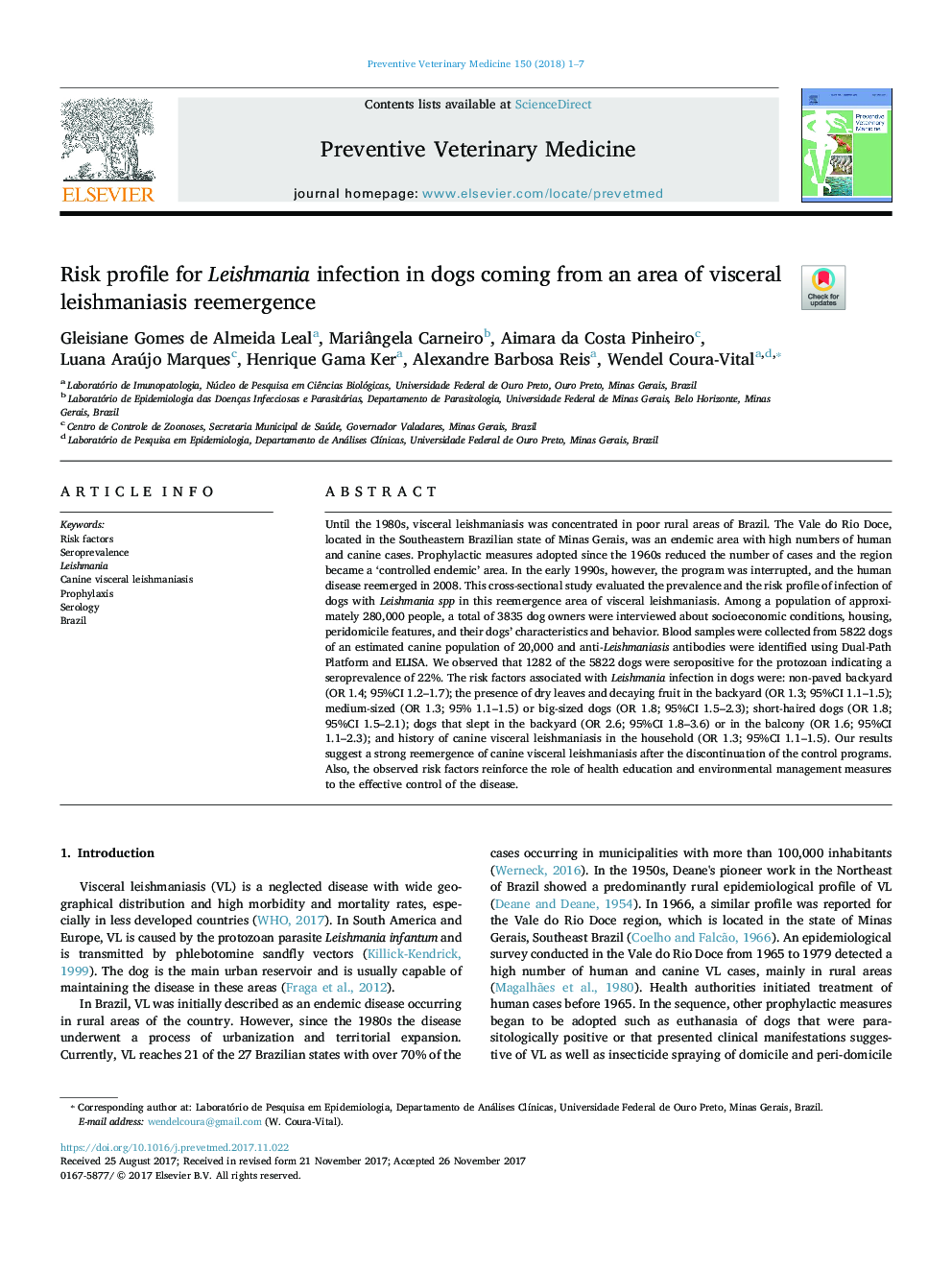| کد مقاله | کد نشریه | سال انتشار | مقاله انگلیسی | نسخه تمام متن |
|---|---|---|---|---|
| 8503546 | 1554140 | 2018 | 7 صفحه PDF | دانلود رایگان |
عنوان انگلیسی مقاله ISI
Risk profile for Leishmania infection in dogs coming from an area of visceral leishmaniasis reemergence
ترجمه فارسی عنوان
مشخصات خطر برای عفونت لیشمانیا در سگ های ناشی از ناحیه لیشمانیوز احشاء
دانلود مقاله + سفارش ترجمه
دانلود مقاله ISI انگلیسی
رایگان برای ایرانیان
کلمات کلیدی
عوامل خطر، سرولوژیک، لیشمانیا، لیشمانیوز احشایی سگ، پیشگیری سرولوژی، برزیل،
موضوعات مرتبط
علوم زیستی و بیوفناوری
علوم کشاورزی و بیولوژیک
علوم دامی و جانورشناسی
چکیده انگلیسی
Until the 1980s, visceral leishmaniasis was concentrated in poor rural areas of Brazil. The Vale do Rio Doce, located in the Southeastern Brazilian state of Minas Gerais, was an endemic area with high numbers of human and canine cases. Prophylactic measures adopted since the 1960s reduced the number of cases and the region became a 'controlled endemic' area. In the early 1990s, however, the program was interrupted, and the human disease reemerged in 2008. This cross-sectional study evaluated the prevalence and the risk profile of infection of dogs with Leishmania spp in this reemergence area of visceral leishmaniasis. Among a population of approximately 280,000 people, a total of 3835 dog owners were interviewed about socioeconomic conditions, housing, peridomicile features, and their dogs' characteristics and behavior. Blood samples were collected from 5822 dogs of an estimated canine population of 20,000 and anti-Leishmaniasis antibodies were identified using Dual-Path Platform and ELISA. We observed that 1282 of the 5822 dogs were seropositive for the protozoan indicating a seroprevalence of 22%. The risk factors associated with Leishmania infection in dogs were: non-paved backyard (OR 1.4; 95%CI 1.2-1.7); the presence of dry leaves and decaying fruit in the backyard (OR 1.3; 95%CI 1.1-1.5); medium-sized (OR 1.3; 95% 1.1-1.5) or big-sized dogs (OR 1.8; 95%CI 1.5-2.3); short-haired dogs (OR 1.8; 95%CI 1.5-2.1); dogs that slept in the backyard (OR 2.6; 95%CI 1.8-3.6) or in the balcony (OR 1.6; 95%CI 1.1-2.3); and history of canine visceral leishmaniasis in the household (OR 1.3; 95%CI 1.1-1.5). Our results suggest a strong reemergence of canine visceral leishmaniasis after the discontinuation of the control programs. Also, the observed risk factors reinforce the role of health education and environmental management measures to the effective control of the disease.
ناشر
Database: Elsevier - ScienceDirect (ساینس دایرکت)
Journal: Preventive Veterinary Medicine - Volume 150, 1 February 2018, Pages 1-7
Journal: Preventive Veterinary Medicine - Volume 150, 1 February 2018, Pages 1-7
نویسندگان
Gleisiane Gomes de Almeida Leal, Mariângela Carneiro, Aimara da Costa Pinheiro, Luana Araújo Marques, Henrique Gama Ker, Alexandre Barbosa Reis, Wendel Coura-Vital,
